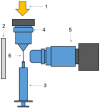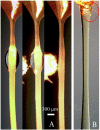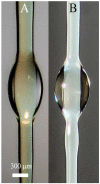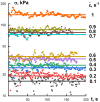A Novel Technique for Fiber Formation: Mechanotropic Spinning-Principle and Realization
- PMID: 30960781
- PMCID: PMC6403789
- DOI: 10.3390/polym10080856
A Novel Technique for Fiber Formation: Mechanotropic Spinning-Principle and Realization
Abstract
We present basic experimental data and the theoretical background of a novel technique for fiber spinning from polymer solutions. The principal feature of the advanced process is realization of phase separation with detachment of a solvent, accompanied by the orientation of macromolecules, under the action of high extension rates. This is similar in some respects to dry spinning, though the driving force is not diffusion with subsequent evaporation of a solvent but redistribution of polymer-solvent interactions in favor of polymer-polymer and solvent-solvent ones governed by mechanical stresses. A promise of this approach has been demonstrated by experiments performed with polyacrylonitrile solutions in different solvents and solutions of the rigid-chain aromatic polyamide. We examined mechanotropic fiber spinning in model experiments with stretching jets from a drop of polymer solution in different conditions, and then demonstrated the possibility of realizing this process in the stable long-term continuous mode. During extension, phase separation happens throughout the whole section of a jet, as was confirmed by visual observation. Then a solvent diffuses on a jet surface, forming a liquid shell on the oriented fiber. Instability of this cover due to surface tension leads either to formation of separate solvent drops "seating" on the fiber or to the flow of a solvent down to the Taylor cone. The separate liquid droplets can be easily taken off a fiber. The physics underlying this process is related to the analysis of the influence of macromolecule coil-to-stretched chain transition on the intermolecular interaction.
Keywords: aromatic polyamide; fiber spinning; phase separation; polyacrylonitrile; polymer solutions; uniaxial extension.
Conflict of interest statement
The authors declare no conflict of interests.
Figures


















References
-
- Vinogradov G.V., Malkin A.Y., Volosevich V.V., Shatalov V.P., Yudin V.P. Flow, high-elastic (recoverable) deformations and rupture of uncured high MW linear polymers in unaxial extension. J. Polym. Sci. Polym. Phys. Ed. 1975;13:1721–1735. doi: 10.1002/pol.1975.180130906. - DOI
-
- Vinogradov G.V., Malkin A.Y., Volosevich V.V. Some fundamental problems in viscoelastic behavior of polymers in shear and extension. Appl. Polym. Symp. 1975;27:47–59.
-
- Meissner J. Experimental aspects in polymer melt elongational rheology. Chem. Engngy Commun. 1985;33:159–180. doi: 10.1080/00986448508911167. - DOI
-
- Spiegelberg S.H., McKinley G.H. Stress relaxation and elastic decohesion of viscoelastic polymer solutions un extensional flow. J. Non-Newton. Fluid Mech. 1996;67:49–76. doi: 10.1016/S0377-0257(96)01475-9. - DOI
-
- Malkin A.Y., Petrie C.J.S. Some conditions for rupture of polymer liquids in extension. J. Rheol. 1997;41:1–25. doi: 10.1122/1.550881. - DOI
Grants and funding
LinkOut - more resources
Full Text Sources

